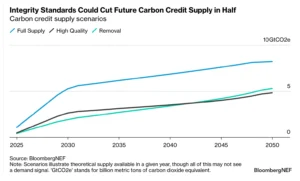To hit its 2050 decarbonization targets, the U.S. is focused on tripling its nuclear power, adding over 200 GW of new capacity. Net-zero models highlight the need for this expansion, but how will the U.S. make it happen? The key strategies include deploying advanced reactors, streamlining regulations, boosting public-private partnerships, and investing in critical infrastructure. These steps will pave the way for a cleaner, more sustainable energy future.
The U.S. currently operates 94 nuclear reactors across 54 sites, providing about 20% of the nation’s electricity and nearly half of its carbon-free energy. These reactors are Light Water Reactors (LWRs), with 63 pressurized water reactors and 31 boiling water reactors. The average capacity of these reactors is 1031 MW, with the smallest at 519 MW and the largest at 1401 MW.
Unlocking the U.S. Nuclear Energy Future with Gen III+ and IV Reactors
The DOE has explained the need for both Gen III+ and Generation IV reactors to meet the 3X capacity by 2050. For example, LWRs, bolstered by the recently launched Gen III+ reactors at Vogtle are highly efficient in meeting the immediate energy demands.
Generation IV reactors, on the other hand, offer the advantage of producing higher temperatures, which are ideal for industrial uses. Although some of these designs date back to the 1950s, they have limited operational experience. This means they will need significant investment to reach commercial viability.
Advanced nuclear includes Gen III+ and Gen IV reactors of all sizes

Source: DOE report
Cost Efficiency, Selection, and Standardization of Nuclear Reactors
Making nuclear energy more affordable hinges on selecting and standardizing reactor designs. Different markets, however, need other solutions that are ideal for large-scale electricity generation, such as powering data centers. In contrast, industries needing high heat or steam may benefit from next-gen technologies like Gen IV reactors. Remote areas may require more specialized designs.
Multi-unit plants help cut costs, with a 30% per megawatt-hour saving compared to single-unit plants. While 19 sites host a single reactor, others have two or more, and Vogtle stands out with four reactors. Public support for nuclear energy remains strong, with 91% of residents near plants backing it.
Many current nuclear sites could expand with new reactors like Small Modular Reactors (SMRs) or larger designs. For example, North Carolina’s Shearon Harris plant, originally designed for four reactors, runs just one. SMRs, which are smaller than 350 MW, are seen as a key to reducing costs through factory production. Their small size makes them useful for remote areas, military bases, and industries that rely on expensive diesel generators. Similarly, microreactors which are generally smaller than 50 MW are often used for the same purpose.
To succeed, SMR construction must maximize factory production. Additionally, reducing on-site construction will help lower costs and make nuclear energy more competitive.
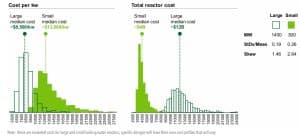
Source: DOE report
A MESSAGE FROM URANIUM ROYALY CORP.
[Disseminated on behalf of Uranium Royalty Corp.]
How To Get Ahead In The Nuclear Renaissance.
Uranium Royalty Corp. is a pure-play uranium royalty company focused on gaining exposure to uranium prices by making strategic investments in uranium interests, including royalties, streams, debt and equity investments in uranium companies, as well as through holdings of physical uranium.
Learn more about their portfolio of geographically diversified uranium interests >>
________________________________________________________________________
The 3 Phases to Achieve Nuclear Liftoff by 2050
A Robust Orderbook
The first step to nuclear expansion is securing 5–10 reactor orders by 2025. This committed orderbook is key for suppliers to invest in manufacturing and reduce costs. Early orders will allow the industry to ramp up production without overloading the supply chain. Delaying these orders until 2030 would raise costs by over 50% and make it harder to hit 2050 decarbonization goals.
On-Time Project Delivery
After the initial demand, delivering the first projects on time and within budget is crucial. The nuclear industry must ensure each phase, from design to licensing, is done efficiently. Meeting construction deadlines will build confidence and prove that future reactors can be completed successfully.
Scaling the Industry
As demand grows, the nuclear industry must expand its workforce, supply chains, and fuel capacity. Reaching 200 GW by 2050 will require scaling up every part of the nuclear ecosystem, from components to spent-fuel management. This industrial growth is essential for supporting the long-term deployment of nuclear energy.
Delaying new nuclear deployment could increase the cost of decarbonization

Source: DOE Report
U.S. Nuclear Growth Requires Major Expansion in Uranium Supply Chain
The DOE has given utmost importance to the need to boost uranium supply to reach the goal of 300 GW of nuclear power. The uranium enrichment pathway looks like this:
The nuclear fuel supply chain has four key steps

Source: DOE report
Mining and Milling
The nation will need 55,000 – 75,000 metric tons (MT) of uranium (U3O8) each year to hit the 2050 target. Currently, the country only produces 2,000 MT annually and has procured 22,000 MT. In 2014, U.S. uranium production peaked at 2,263 MT. To meet future demand, the US will have to increase its production by about 71,000 MT annually.
Conversion Capacity
U.S. will require 70,000 to 95,000 MT of uranium hexafluoride (UF6) conversion capacity. Right now, the country has 10,400 MT of capacity. The Metropolis Works facility, the nation’s sole UF6 converter, reopened in July 2023 after a six-year shutdown. However, this restart alone will not be enough to meet rising demand.
Enrichment Needs
The U.S. needs to boost its uranium enrichment from its current 4.4 million separative work units (SWU) per year to between 45 and 55 million SWU to support 300 GW of nuclear capacity. Generation IV reactors require high-assay low-enriched uranium (HALEU), enriched to 19.75%. At present, the U.S. relies on a single HALEU facility, producing only 900 kg annually. The DOE is taking steps to create a domestic HALEU supply chain through programs like the HALEU Availability Program, which is backed by $700 million from the Inflation Reduction Act.
Fabrication
The U.S. must also increase its uranium fuel fabrication capacity to between 6,000 and 8,000 MTU annually to support 300 GW of nuclear capacity. Its current capacity stands at 4,200 MT. In addition, advanced reactors will need new fuel types, such as TRISO and metallic fuels. Companies like TerraPower and X-energy are leading projects to develop these advanced fuels. X-energy’s TRISO-X facility, set to begin operations in 2025, will help meet these demands.
International Cooperation
The U.S. leads the “Sapporo 5” coalition, which includes the U.K., France, Japan, and Canada. Together, they have pledged $4.2 billion to invest in nuclear fuel services, including enrichment and conversion. The U.S. has committed $3.42 billion to secure a stable nuclear fuel supply chain and is working closely with its partners to eliminate bottlenecks in the supply chain.
By strengthening its uranium supply chains and collaborating with global partners, the U.S. is positioning itself for significant nuclear growth while ensuring energy independence and a secure domestic supply.
U.S. Nuclear Restarts Spark Fresh Demand for Uranium Amid Tight Supply
In September, the U.S. nuclear sector received a significant boost from DOE to restart major reactors, creating fresh demand for uranium amid a tight global supply chain. These developments mark a clear shift toward nuclear growth in the nation.
S&P Global mentioned, Jonathan Hinze, president of the UxC nuclear fuel consultancy remarked,
“Each of these reactors will use up to 500,000 lb U3O8 annually, and that demand has yet to fully hit the market. While the incremental increase in demand is not that large, any additional fuel purchasing by utilities will likely be felt in the current market given very tight supply-demand fundamentals across the nuclear fuel cycle.”
On Sept. 30, the Biden administration approved a $1.52 billion conditional loan guarantee to restart the 800-MW Palisades nuclear plant in Covert, Michigan. Just days earlier, on Sept. 20, Constellation Energy Corp. announced plans to restart the Three Mile Island Unit 1 nuclear plant in Pennsylvania, partnering with Microsoft to power its data centers.
Uranium Prices Rise on Reactor Restarts
Pricing is a key factor in the nuclear energy comeback. According to S&P Global, spot uranium prices have only seen a slight rise since recent announcements, but the sector is now trending upward. The price has quadrupled from its late-2010s level, fueled by renewed interest in nuclear energy. After the 2011 Fukushima disaster, the uranium market slumped for years. However, prices soared past $100 per pound in early 2024, driven by improved investor confidence.
Recent reactor restarts mark a sharp turnaround for the U.S. nuclear sector, which saw 13 reactors close between 2013 and 2022. Analysts now see more potential for growth. CIBC analysts believe these restarts will further boost the uranium market, especially as the power-hungry AI industry increases demand for energy to run data centers.

Source: S&P Global
Will it Put Pressure on Uranium Supply?
S&P Global further analyzed the situation. They anticipate the revival of nuclear plants is expected to intensify uranium demand. Consequently, driving up prices and challenging supply chains. Scott Melbye, president of the Uranium Producers of America, pointed out that Constellation’s restart will cut into its nuclear fuel reserves, further tightening an already constrained market.
Currently, global geopolitical tensions have also impacted the nuclear fuel market. The ongoing Russia-Ukraine war has led to disruptions, with the U.S. banning enriched uranium imports from Russia in April 2023. While waivers allow some imports until 2028, the market remains under pressure as Russia considers retaliatory export cuts.
With more countries, including the U.S., committing to tripling nuclear power by 2050, the sector is poised for long-term growth. As nuclear energy regains momentum, it is positioned as a critical component in global efforts to reduce carbon emissions and combat climate change.
6 Reasons Why Nuclear Energy Will Rule the Decarbonized Future
Here are six important reasons nuclear energy plays a key role in the journey to net-zero emissions:
- Generates electricity with almost no carbon emissions, making it essential for reducing reliance on fossil fuels.
- Provides constant, reliable electricity, crucial for stabilizing the grid as renewable sources grow.
- Nuclear plants produce far more electricity per acre than solar or wind, making them ideal for regions with limited space.
- They create high-paying jobs and stimulate local economies, especially in regions like the U.S. Southeast.
- Supports industrial processes like hydrogen production, benefiting industries beyond just power generation.
- Requires fewer raw materials than renewables, reducing environmental impact and conserving critical resources.
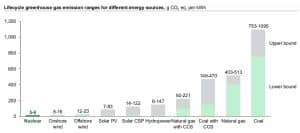
Source: DOE Report
In conclusion, nuclear energy will play a pivotal role in the U.S.’s transition to a cleaner, more resilient grid, supporting economic growth and reducing emissions.
Source: Advanced Nuclear Commercial LiftOff
- MUST READ: The Atomic Awakening
The post What Does the U.S. Need to Triple Its Nuclear Capacity by 2050? DOE Explains… appeared first on Carbon Credits.
Carbon Footprint
Carbon Credit Market Gains Integrity With ICVCM’s Approval of 6 New Removal Standards
The voluntary carbon market (VCM) has taken a major step forward. The Integrity Council for the Voluntary Carbon Market (ICVCM) has approved six new carbon removal methodologies under its Core Carbon Principles (CCPs). These methods come from two programs: Isometric and Gold Standard. Both are known for meeting the council’s strict requirements.
This approval signals a shift toward stronger credibility in carbon removal credits. For years, the voluntary carbon market faced doubts about quality, transparency, and permanence.
Many companies hesitated to use credits due to fears of overstated benefits. The ICVCM names specific methods that meet high integrity standards. This helps businesses, investors, and governments have a clearer framework to trust. In the words of Annette Nazareth, ICVCM Chair:
“We are pleased to announce these new approvals for methodologies in a variety of emissions reductions and removals categories. The science is clear that both reductions and removals are critical to effective climate action. These latest approvals will open up new options for integrity-focused buyers to broaden their portfolios of carbon credits across a range of high-impact categories.”
The New Approved Standards
The six approved carbon removal methodologies include the following:
- Gold Standard — Carbon Sequestration Through Accelerated Carbonation of Concrete Aggregate (v1.0)
- Isometric — Biomass Geological Storage (v1.0–v1.1)
- Isometric — Bio-oil Geological Storage (v1.0–v1.1)
- Isometric — Subsurface Biomass Carbon Removal and Storage (v1.0)
- Isometric — Biogenic Carbon Capture and Storage (v1.1)
- Isometric — Direct Air Capture (v1.1)
In addition, the ICVCM confirmed two nature-based methodologies under other programs: CAR Mexico Forest Protocol v3 for improved forest management and VM0047 v1.1 for afforestation and reforestation.
These approvals matter because they are linked to very specific versions of methodologies. Not all projects under Isometric or Gold Standard automatically qualify. Only those that follow these approved versions can carry the CCP label.
From Doubts to Trust: Raising the Bar on Carbon Credits
So far, projects under these new removal methods have issued around 30,000 credits. While this number is small, the pipeline is much larger. ICVCM data show that:
- 24 projects under the Isometric methods are expected to issue over 3.2 million credits annually in the coming years.
- 15 projects under the Gold Standard method could issue over 9,000 credits annually.
In forestry, the CAR Mexico Forest Protocol v3 already has more than 8.1 million credits issued. However, not all will automatically qualify under the CCP label because of new permanence and leakage rules. For example, the protocol now requires a 40-year permanence commitment and allows leakage rates of up to 40%.
This level of detail adds clarity and accountability. It helps ensure that CCP-approved credits represent real, measurable, and durable climate outcomes.
From Billions to Trillions: The Future of Carbon Removal
The carbon removal market is still small compared to the scale of global emissions. Today, VCMs are valued at about $2 billion annually. Forecasts suggest they could reach up to $100 billion by 2030. Carbon removal will be central to that growth.

Currently, removals make up less than 1% of all credits sold. Most credits still come from avoided emissions, such as preventing deforestation. But future sales are shifting toward removals.
Buyers are showing stronger interest in forward contracts for engineered removals, like direct air capture, bio-oil storage, and biomass geological storage.
Analysts project that DAC capacity could reach 60–100 million tons per year by 2035, up from near zero today. Meanwhile, biochar, enhanced weathering, and subsurface storage are also scaling. These new CCP approvals provide the quality assurance needed to attract investment at this level.
Carbon market growth rates are projected at 25–30% annually through the next decade. By 2050, the sector could generate more than $1 trillion annually, reflecting the scale of removals needed to reach climate goals.
Four Forces Powering the Carbon Removal Boom
Several forces are pushing removals into the mainstream.
- Corporate Net-Zero Goals – More than 5,000 companies worldwide have pledged to reach net zero. Many will rely on removals to balance emissions they cannot fully cut.
- Government Policy – U.S. and European policies, such as the Inflation Reduction Act and the EU Green Deal, provide tax credits and funding for carbon capture.
- Investor Confidence – Clear CCP standards make investors more willing to finance high-quality projects.
- Technology Scaling – Costs for engineered removals like DAC and bio-oil storage are expected to fall as projects scale up.
These trends show why carbon removal is becoming not just a side option but a pillar of climate strategy.
The Price of Permanence: Barriers Still Loom
Even with new approvals, challenges remain. Engineered removals are expensive. Current costs for direct air capture range from $300 to $600 per ton. Experts say this needs to fall below $100 per ton for widespread adoption.
Nature-based removals, while cheaper, raise other questions. Land use, biodiversity impacts, and long-term monitoring must be managed carefully. For example, requiring 40-year permanence adds credibility but also creates financial and operational hurdles for project developers.
The Integrity Council will need to enforce ongoing monitoring, verification, and auditing. Without strong oversight, credibility could erode again.
Why This Matters for Business and Capital
For companies, the approval of Isometric and Gold Standard removals offers more reliable ways to meet net-zero targets. Purchasing CCP-approved carbon credits reduces reputational risks and demonstrates a commitment to real climate action.
For investors, these standards provide a clearer signal about which projects are worth funding. Capital can flow toward technologies and practices that deliver measurable and permanent removals.
Carbon Markets 2030 and Beyond
The ICVCM decision is a foundation for growth. By 2030, analysts expect carbon removal to represent a much larger share of the voluntary market.

Government integration will be another milestone. Both the UK and EU are exploring whether to allow carbon removals in their compliance systems within the next five years. If CCP-approved removals are included, demand could rise sharply.
The Integrity Council’s approval of six new methodologies from Isometric and Gold Standard represents a turning point for carbon markets. These decisions provide greater transparency, stronger safeguards, and a clearer path for scaling carbon removal.
While challenges remain in cost, permanence, and oversight, the foundation for trust is stronger than before. With new standards in place, the carbon removal market can grow from thousands to millions—and eventually billions—of tons of CO₂ removed. This shift is critical to balancing global emissions and moving closer to a net-zero future.
The post Carbon Credit Market Gains Integrity With ICVCM’s Approval of 6 New Removal Standards appeared first on Carbon Credits.
Carbon Footprint
Lithium’s Turning Point: DOE Investment in LAC’s Thacker Pass and the LIT ETF Rally
Lithium has become one of the most critical resources for the global energy transition. As demand for electric vehicles (EVs) and renewable energy storage grows, countries are racing to secure stable supplies of this lightweight metal.
In the United States, the Department of Energy (DOE) has just announced a new era for lithium production. At the same time, investor interest in lithium has surged, reflected by the strong monthly close of the Global X Lithium & Battery Tech ETF (LIT). These changes show that the lithium market is reaching an important stage. This stage is shaped by policy, technology, and financial momentum.
U.S. DOE Takes a Stake in Lithium Americas
The DOE recently confirmed it will take equity stakes in Lithium Americas and its Thacker Pass mine in Nevada. This move marks the first time the U.S. government has directly invested in a lithium project rather than providing loans or guarantees.
Thacker Pass is one of the biggest lithium deposits in North America. It could greatly decrease U.S. dependence on foreign sources.
Becoming a shareholder sends a clear message: lithium production is vital for both business and national security. China controls over 60% of global lithium refining. So, the U.S. wants to boost its own supply chains.
The government aims to support projects that ensure long-term stability. The government’s role lowers risk for private investors. This could lead to more funding and partnerships.
Thacker Pass: America’s White Gold Standard
Thacker Pass, located in northern Nevada, is set to produce lithium carbonate. This will provide enough for batteries in up to one million EVs each year when fully operational. Construction is underway, and production is expected later this decade. The mine could make the U.S. one of the top four global producers, alongside Chile and Australia.
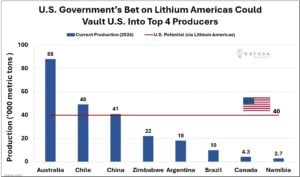
Thacker Pass has not been without controversy, facing environmental opposition and legal challenges. However, federal and state support has kept the project moving forward. If successful, it could reshape the balance of supply in the Western Hemisphere and reduce reliance on imports from Asia.
A Global Tug-of-War for Lithium Supply
While the U.S. builds its domestic base, other regions are also reconfiguring supply chains.
- Chile and Argentina hold about 60% of the world’s lithium reserves. They are rethinking their royalty rules and partnerships to bring in more foreign investment.
- Australia, currently the largest producer, continues to expand mining output but faces bottlenecks in refining. Much of its raw spodumene is shipped to China for processing.
- China, a leader in refining and cathode production, is boosting investments in Africa and South America. This helps it maintain its top position.
This global tug-of-war reflects a broader reality: lithium is not only an industrial commodity but also a strategic resource. Countries are ensuring access by using different methods. They invest directly, make long-term supply agreements, and innovate with technology.
EVs and Energy Storage: The Demand Engine
Lithium demand will likely surge in the next ten years. This rise is due to more people using EVs and increasing grid-scale energy storage. BloombergNEF forecasts lithium-ion battery demand reaching multiple terawatt-hours annually by 2035. EVs will likely make up over 70% of this total.
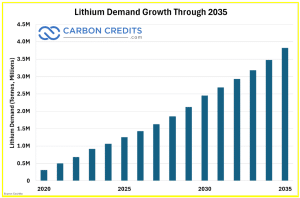
In the U.S., new federal incentives under the Inflation Reduction Act are pushing automakers to source more domestically produced materials. Ford, General Motors, and Tesla have all made deals for lithium. They expect the market to get tighter.
Meanwhile, utilities are using large battery storage systems. These help balance renewable energy from sources like wind and solar. This shift is increasing demand even more.
New Frontiers: Direct Extraction and Recycling
Meeting future demand will not only depend on mining new deposits but also on deploying new technologies. Direct lithium extraction (DLE) methods can boost recovery rates. They also lower environmental impact compared to old evaporation ponds. Companies in the U.S. and South America are piloting these systems, and if successful, DLE could accelerate supply growth.
Recycling also represents a growing opportunity. As the first wave of EV batteries reaches the end of life, recycling firms are stepping in to recover valuable metals. This secondary supply could become increasingly important in balancing markets and reducing dependence on mining.
Price Trends and Market Volatility
Lithium prices have seen dramatic swings in recent years. After hitting record highs in 2022, prices corrected in 2023 and 2024 as supply temporarily outpaced demand.
However, analysts warn that volatility is likely to persist. Benchmark Mineral Intelligence says lithium carbonate prices steadied in 2025. However, rising demand from EV makers could trigger another price surge in the late 2020s.
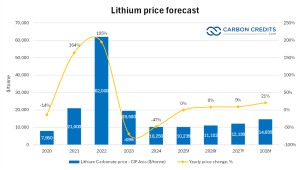
This volatility underscores the challenges for both producers and investors. Companies should balance long-term supply contracts with the risk of falling prices. Investors need to consider cyclical downturns alongside the bigger growth picture.
LIT ETF’s Rally Sparks Renewed Optimism
One sign of renewed optimism in the sector is the recent performance of the Global X Lithium & Battery Tech ETF (LIT). The ETF, which tracks a broad portfolio of lithium miners, battery producers, and EV companies, just posted its strongest monthly close in over a year, as seen in the Katusa Research chart below.
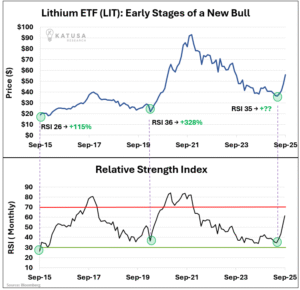
This performance reflects investor belief that the worst of the price downturn may be over and that long-term fundamentals remain intact. Stronger government backing, such as the DOE’s investment, adds further support to the outlook.
For many investors, ETFs like LIT offer diversified exposure to a sector known for both opportunity and volatility.
Investment Playbook: Choosing Exposure Wisely
For investors, the lithium sector presents both risks and rewards. On one hand, rising demand for EVs and energy storage supports a strong long-term growth story. On the other hand, price volatility, environmental concerns, and geopolitical risks remain significant.
Investors generally face three approaches:
- Major producers like Albemarle, SQM, and Ganfeng provide scale and stability.
- Emerging juniors, such as Lithium Americas, offer high growth potential but higher risks.
- ETFs like LIT provide diversified exposure, spreading risk across multiple companies and regions.
Each option carries different risk-reward profiles, making diversification a key strategy.
A Defining Decade for Lithium
The lithium industry is entering a transformative period. The DOE’s investment in Thacker Pass shows how vital it is to secure supply chains. Moreover, the strong close of the LIT ETF reflects rising investor confidence in this sector’s future. Globally, shifts in supply, demand, and technology are reshaping the landscape.
As EV adoption accelerates and renewable energy expands, lithium will remain a cornerstone of the energy transition. For governments, it is a matter of security and independence. For companies, it is a race to innovate and scale. And for investors, it represents both opportunity and volatility.
The next decade will likely define how lithium shapes the clean energy future, making today’s developments critical signals of what lies ahead.
- FURTHER READING: U.S. Lithium Push: How Washington’s Bet on Lithium Americas Could Reshape the Global Market
The post Lithium’s Turning Point: DOE Investment in LAC’s Thacker Pass and the LIT ETF Rally appeared first on Carbon Credits.
Carbon Footprint
Politics and Prevention – Fentanyl at the Center of U.S. Security and Leadership
* Disseminated on behalf of ARMR Sciences Inc.
* For Accredited Investors Only. Offered pursuant to Rule 506(c). Reasonable steps to verify accreditation will be taken before any sale.
PAID ADVERTISEMENT – SPONSORED CONTENT
Fentanyl is not just a public health crisis – it has become a defining political issue in the United States. The synthetic opioid is now the leading cause of death for Americans aged 18–45, killing an estimated 220 people every day.
As the toll rises, many political leaders, border agencies, and private innovators are converging on one message: fentanyl control is a matter of national security.
A Political Priority
President Donald Trump has made fentanyl control a centerpiece of his drug policy priorities. These priorities include attacking production and distribution networks, using both punitive (law enforcement) and economic tools. Trump has vowed that his “highest duty is the defense of the country and its citizens,” promising to intensify measures against cartels and traffickers responsible for smuggling synthetic opioids across the southern border.
The bipartisan urgency is clear. Lawmakers across party lines now view fentanyl not only as a public health emergency but also as a national security threat on par with terrorism and cyberwarfare. This framing should open the door to expanded federal funding, new enforcement powers, and increased support for innovative countermeasures, such as immunotherapies.
Borders Under Pressure
Most illicit fentanyl in the U.S. is manufactured abroad, often in China, and trafficked through Mexico, where it enters across official and unofficial border crossings. U.S. Customs and Border Protection has reported record seizures in recent years.
Canada, too, has experienced rising seizures and overdose deaths, underlining that this is not a U.S.-only crisis but a North American challenge.
Deployments of additional detection technology, canine units, and chemical sensors are underway at key border points. Yet border agents acknowledge they are overwhelmed: with traffickers mixing fentanyl into counterfeit pills or powder, even small gaps in enforcement can lead to mass fatalities.
ARMR’s Role in a Political Landscape
The fentanyl crisis is a political flashpoint that blends public health, security, and foreign policy. Border enforcement will remain essential, but no interdiction strategy can stop every shipment.
We believe that this climate creates fertile ground for ARMR Sciences’ preventive approach. Unlike Narcan, which only works after an overdose has begun, ARMR-100 (ARMR’s lead candidate) is designed to block fentanyl before it reaches the brain. For policymakers, this aligns with national security goals: a proactive solution that reduces the burden on border interdiction and first responders.
Why Investors Should Pay Attention
For investors, we believe that ARMR represents an opportunity to participate in a mission that is as much about impact as it is about returns. The company is working to translate 7 years of Department of Defense–backed science into a scalable biodefense platform:
- Lead candidate ARMR-100 blocked 92% of fentanyl from entering the brain in preclinical studies
- $30M private raise launched
- A targeted exchange listing in the future
- Direct alignment with political momentum on anti-fentanyl measures
With strong bipartisan focus and rising border enforcement pressure, companies like ARMR offering real solutions should be positioned to benefit from both government backing and investor interest.
By investing in this round, investors have a chance to back ARMR as it works to build a preventive shield against synthetic drug threats.
* For Accredited Investors Only. This offering is made pursuant to Rule 506(c) of Regulation D. All purchasers must be accredited investors, and the issuer will take reasonable steps to verify accredited status before any sale. Investing involves high risk, including the potential loss of your entire investment.
* This is a paid advertisement for ARMR’s private offering. Please read the details of the offering at InvestARMR.com for additional information on the company and the risk factors related to the offering.
* For investors from Canada: This advertisement forms part of the issuer’s marketing materials and is incorporated by reference into the issuer’s Offering Memorandum/Private Placement Memorandum under NI 45-106. Investors must receive and review the OM/PPM and execute the prescribed Form 45-106F4 Risk Acknowledgement before subscribing.
DISCLOSURES & DISCLAIMERS
CLIENT CONTENT: Carboncredits.com is not responsible for any content hosted on ARMR Sciences’ sites; it is ARMR Sciences’ responsibility to ensure compliance with applicable laws.
NOT INVESTMENT ADVICE: Content is for educational, informational, and advertising purposes only and should NOT be construed as securities-related offers or solicitations. All content should be considered promotional and subject to disclosed conflicts of interest.
Do NOT rely on this as personalized investment advice. Do your own due diligence.
Carboncredits.com strongly recommends you consult a licensed or registered professional before making any investment decision.
REGULATORY STATUS: Neither Carboncredits.com nor any of its owners or employees is registered as a securities broker-dealer, broker, investment advisor, or IA representative with the U.S. Securities and Exchange Commission, any state securities regulatory authority, or any self-regulatory organization.
CONTENT & COMPENSATION DISCLOSURE: Carboncredits.com has received compensation of thirty thousand dollars from ARMR Sciences for this sponsored content. You should assume we receive compensation as indicated for any purchases through links in this email via affiliate relationships, direct/indirect payments from companies or third parties who may own stock in or have other interests in promoted companies. We may purchase, sell, or hold long or short positions without notice in securities mentioned in this communication.
RESULTS NOT TYPICAL: Past performance and results are unverified and NOT indicative of future results. Results presented are NOT guaranteed as TYPICAL. Market conditions and individual circumstances vary significantly. Actual results will vary widely. Investing in securities is speculative and carries high risk; you may lose some, all, or possibly more than your original investment.
HIGH-RISK: Securities discussed may be highly speculative investments subject to extreme volatility, limited liquidity, and potential total loss. The Securities are suitable only for persons who can afford to lose their entire investment. Furthermore, investors must understand that such investment could be illiquid for an indefinite period of time. No public market currently exists for the securities, and if a public market develops, it may not continue.
DISCLAIMERS & CAUTIONARY STATEMENT: Certain statements in this presentation (the “Presentation”) may be deemed to be “forward-looking statements” within the meaning of Section 27A of the 1933 Securities Act and Section 21E of the Exchange Act of 1934, as amended, and are intended to be covered by the safe harbor provisions for forward-looking statements. Such forward-looking statements can be identified by the use of words such as ”should,” ”may,” ”intends,” ”anticipates,” ”believes,” ”estimates,” ”projects,” ”forecasts,” ”expects,” ”plans,” and ”proposes.” Forward-looking statements, which are based on the current plans, forecasts and expectations of management of ARMR Sciences Inc. (the “Company” or “ARMR Sciences”), are inherently less reliable than historical information. Forward-looking statements are subject to risks and uncertainties, including events and circumstances that may be outside our control.
Although management believes that the expectations reflected in these forward-looking statements are based on reasonable assumptions, there are a number of risks and uncertainties that could cause actual results to differ materially from such forward-looking statements. Risks and uncertainties that could cause actual results to differ materially include, without limitation, those risks identified in the Private Placement Memorandum. Forward-looking statements speak only as of the date of the document in which they are contained, and ARMR Sciences Inc. does not undertake any duty to update any forward-looking statements except as may be required by law.
Any forward-looking financial forecasts contained in this Presentation are subject to a number of risks and uncertainties, and actual results may differ materially. You are cautioned not to place undue reliance on such forecasts. No assurances can be given that the future results indicated, whether expressed or implied, will be achieved. While sometimes presented with numerical specificity, all such forecasts are based upon a variety of assumptions that may not be realized, and which are highly variable. Because of the number and range of the assumptions underlying any such forecasts, many of which are subject to significant uncertainties and contingencies that are beyond the reasonable control of the issuing company, many of the assumptions inevitably will not materialize and unanticipated events and circumstances may occur subsequent to the date of any financial forecast.
ARMR Sciences Inc. takes no responsibility for any forecasts contained within the Presentation. None of the information contained in any offering materials should be regarded as a representation by ARMR Sciences Inc. The Company’s forecasts have not been prepared with a view toward public disclosure or compliance with the guidelines of the SEC, the American Institute of Certified Public Accountants or the Public Company Accounting Oversight Board. Independent public accountants have not examined nor compiled any forecasts and have not expressed an opinion or assurance with respect to the figures.
This Presentation also contains estimates and other statistical data made by independent parties and by management relating to market size and other data about our industry. This data involves a number of assumptions and limitations, and you are cautioned not to give undue weight to such estimates.
ARMR Sciences Inc. is currently undertaking a private placement offering of Offered Shares pursuant to Section 4(a)(2) of the 1933 Act and/or Rule 506(c) of Regulation D promulgated thereunder. Investors should consider the investment objectives, risks, and investment time horizon of the Company carefully before investing. The private placement memorandum relating to the offering of Securities will contain this and other information concerning the Company, including risk factors, which should be read carefully before investing.
The Securities are being offered and sold in reliance on exemptions from registration under the 1933 Act. In accordance therewith, you should be aware that (i) the Securities may be sold only to “accredited investors,” as defined in Rule 501 of Regulation D; (ii) the Securities will only be offered in reliance on an exemption from the registration requirements of the Securities Act and will not be required to comply with specific disclosure requirements that apply to registration under the Securities Act; (iii) the United States Securities and Exchange Commission (the “SEC”) will not pass upon the merits of or give its approval to the terms of the Securities or the offering, or the accuracy or completeness of any offering materials; (iv) the Securities will be subject to legal restrictions on transfer and resale and investors should not assume they will be able to resell their securities; and (v) investing in these Securities involves a high degree of risk, and investors should be able to bear the loss of their entire investment. Furthermore, investors must understand that such investment could be illiquid for an indefinite period of time.
The Company is “Testing the Waters” under Regulation A under the Securities Act of 1933. The Company is not under any obligation to make an offering under Regulation A. No money or other consideration is being solicited in connection with the information provided, and if sent in response, will not be accepted. No offer to buy the securities can be accepted and no part of the purchase price can be received until an offering statement on Form 1-A has been filed and until the offering statement is qualified pursuant to Regulation A of the Securities Act of 1933, as amended, and any such offer may be withdrawn or revoked, without obligation or commitment of any kind, at any time before notice of its acceptance given after the qualification date.
The securities offered using Regulation A are highly speculative and involve significant risks. The investment is suitable only for persons who can afford to lose their entire investment. Furthermore, investors must understand that such investment could be illiquid for an indefinite period of time. No public market currently exists for the securities, and if a public market develops following the offering, it may not continue. The Company intends to list its securities on a national exchange and doing so entails significant ongoing corporate obligations including but not limited to disclosure, filing and notification requirements, as well compliance with applicable continued quantitative and qualitative listing standards.
Disclosure: Owners, members, directors, and employees of carboncredits.com have/may have stock or option positions in any of the companies mentioned: None.
Carboncredits.com receives compensation for this publication and has a business relationship with any company whose stock(s) is/are mentioned in this article.
Additional disclosure: This communication serves the sole purpose of adding value to the research process and is for information only. Please do your own due diligence. Every investment in securities mentioned in publications of carboncredits.com involves risks that could lead to a total loss of the invested capital.
Please read our Full RISKS and DISCLOSURE here.
The post Politics and Prevention – Fentanyl at the Center of U.S. Security and Leadership appeared first on Carbon Credits.
-
Climate Change2 years ago
Spanish-language misinformation on renewable energy spreads online, report shows
-
Climate Change Videos2 years ago
The toxic gas flares fuelling Nigeria’s climate change – BBC News
-
Climate Change2 months ago
Guest post: Why China is still building new coal – and when it might stop
-

 Greenhouse Gases1 year ago
Greenhouse Gases1 year ago嘉宾来稿:满足中国增长的用电需求 光伏加储能“比新建煤电更实惠”
-

 Climate Change1 year ago
Climate Change1 year ago嘉宾来稿:满足中国增长的用电需求 光伏加储能“比新建煤电更实惠”
-
Greenhouse Gases2 months ago
Guest post: Why China is still building new coal – and when it might stop
-

 Carbon Footprint1 year ago
Carbon Footprint1 year agoUS SEC’s Climate Disclosure Rules Spur Renewed Interest in Carbon Credits
-
Renewable Energy3 months ago
US Grid Strain, Possible Allete Sale




